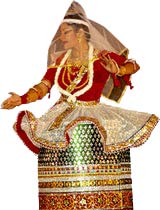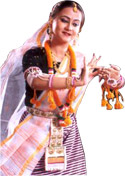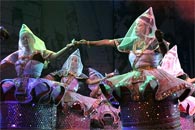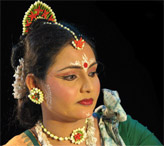MANIPURI
Origin
One of the most known classical dance and which is one among the six classical type dance is Manipuri the other are Bharatanatyam, Kathak, Kathakali, Kuchipudi, and Orissi. Manipuris coming from Manipur the north-eastern state of India and the indigenous people of this valley are known to be the dance-expert as the Gandharva's, mentioned in the epic Ramayana, Mahabharata and other religious scriptures.This style of classical dance is purely religious and its aim is at spiritual experience. The daily activities of Manipuri people include the development of music and dance through religious festivals. Dance is not only a medium of worship and enjoyment but also a door to the divine, but indispensable for all socio-cultural ceremonies. From the religious point of view and from the artistic angle of vision, Manipuri Classical Form of dance is claimed to be one on the most modest, softest and mildest but the most meaningful dances of the world.
 Manipuri dances most obliging aspect of culture is that, it has retained the ancient ritual based dances and folk dances along which is later developed classical Manipuri dance style. Among all the classical categories, 'Ras Leela' - a highly evolved dance drama, choreographed on 'Vaishnavite Padavalis' composed by mainly eminent Bengali poets and there were some Manipuri Gurus, which is the highest expression of artistic genius, devotion and excellence of the Manipuris.
Manipuri dances most obliging aspect of culture is that, it has retained the ancient ritual based dances and folk dances along which is later developed classical Manipuri dance style. Among all the classical categories, 'Ras Leela' - a highly evolved dance drama, choreographed on 'Vaishnavite Padavalis' composed by mainly eminent Bengali poets and there were some Manipuri Gurus, which is the highest expression of artistic genius, devotion and excellence of the Manipuris.
Manipuri is one of the most beautiful dance styles of India which is nurtured in the mountainous region of the northeast; it takes its name fromthe area called Manipur, which is now a state. The word literally means a jewel of a land, and the state is set like a gem in the verdant hills. The legend great significance which goes that the gods drained a lake in the beautiful countryside in order to find a place to dance.
So that way dance is an inherent part of the rituals of daily life, such as weddings and homage to ancestors in their tradition. This particular dance was initially performed only in temples as any other Indian classical dance. The major attraction of Manipuri dance style is the beautiful costumes of the dancers. This dance style got good encouragement of Rabindranath Tagore. Unlike many other dance forms, Manipuri has retained its ancient ritual based dances and folk dances along with the later developed classical Manipuri dance style.
Steps involved in the dance
Manipuri dances' main expression is devotional in nature and is exclusively attached to Hindu deities Radha and Krishna, who are the main characters in Manipuri dances. There are a number of forms in Manipuri like the Rasa Lila, the Pung Cholom, Nupa Cholom, Thoibi and a host of others. Among all of them Rasa Lila is a highly evolved dance drama, choreographed on 'Vaishnavite Padavalis', composed by mainly eminent Bengali poets and some Manipuri Gurus. The major attraction is the costumes of the dance which is the long and flared embroidered skirts from the waist, translucent veils, and long peacock feather crown add radiant appearance to this dance.
There are a number of forms in Manipuri like the Rasa Lila, the Pung Cholom, Nupa Cholom, Thoibi and a host of others. Among all of them Rasa Lila is a highly evolved dance drama, choreographed on 'Vaishnavite Padavalis', composed by mainly eminent Bengali poets and some Manipuri Gurus. The major attraction is the costumes of the dance which is the long and flared embroidered skirts from the waist, translucent veils, and long peacock feather crown add radiant appearance to this dance. The Manipuri dance embodies in itself delicate, lyrical and graceful movements. In contrast to the other Indian classical dance forms, in this dance the dancer’s feet should never strike the ground hard and their facial expressions should be subtle in Manipuri. Manipuri dances another vibrant feature is the Pung Cholam or Drum dance, in which dancers play on the drum known as Pung while dancing with thrilling leaps and turns to a fast rhythm.
Manipuri dances are such dances which are performed always in front of deities. The technique of Manipuri dance is mainly based on an interesting principle of compensatory movement with the objective of achieving rounded movements and avoiding any jerks, sharp edges or straight lines.The Lai Haroba is ritualistic Manipuri dance depicting the Creation which is considered the precursor of Manipuri which is seen today.
 The Lai Haroba is still an important living tradition, while Manipuri has expanded and gained popularity as a performing art in group and solo presentations.
The important constituents among the Manipuri repertoire are the Sankirtana and the Raas Leela, based on the devotional theme of Krishna and Radha. The Raas Leela depicts the cosmic dance of Krishna and the cowherd maidens.
The Lai Haroba is still an important living tradition, while Manipuri has expanded and gained popularity as a performing art in group and solo presentations.
The important constituents among the Manipuri repertoire are the Sankirtana and the Raas Leela, based on the devotional theme of Krishna and Radha. The Raas Leela depicts the cosmic dance of Krishna and the cowherd maidens. Every time the dancer puts down his or her feet, even during vigorous steps, it is the front part of the feet which touch the ground first and 'break the fall'. The ankle and knee joints are effectively used as shock absorbers. The dancer's feet are neither put down nor lifted up at the precise rhythmic points of the music but rather slightly earlier or later to express the same rhythmic points most effectively. Like the movements of the body and feet, the facial expressions in Manipuri dance should be subtle.
It was originally only performed in temples and continues to form an integral part of the religious and social fabric of Manipur. Manipuri dance, whether folk, classical or modern, is devotional in nature. The Manipuri people are very much religious and are exclusively attached to the Hindu deities Radha and Krishna, who are often the main characters depicted in Manipuri dances.
Popular dancers
 The Popular Manipuri dancers are Guru Biping Singh, Bimbavati Devi, being the daughter of renowned classical Manipuri dancer, Guru Bipin Singh. She is even known as a solo artiste and as a performing artiste of Manipuri Nartanalaya, one of the pioneer institutions of Manipuri dance in the country founded by her parents and the well-known Jhaveri sisters.
The Popular Manipuri dancers are Guru Biping Singh, Bimbavati Devi, being the daughter of renowned classical Manipuri dancer, Guru Bipin Singh. She is even known as a solo artiste and as a performing artiste of Manipuri Nartanalaya, one of the pioneer institutions of Manipuri dance in the country founded by her parents and the well-known Jhaveri sisters.
Learning Manipuri Dance
Pushpanjali Mr. Raj KumarAddress : Hotel Star Paradise, 4582,
Main Bazar, Pahar Ganj , New Delhi - 110 055 (INDIA)
Tel No. : +(91)-(11)-23585357, 23561597, 23585211
Fax No. : +(91)-(11)-23586008 Email : [email protected], [email protected]


